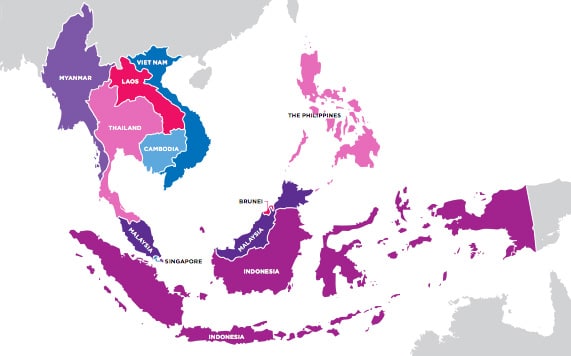ASEAN poised to usher in new era of regional student mobility
The rise in intra-region mobility - that is, the increasing incidence of international students leaving their home country to study in a neighbouring country within their home region - is one of the most important trends in international student mobility today. As reported previously on ICEF Monitor, increases in regional mobility are being fueled by improved capacity and quality in regional education hubs, and also by student preference for the greater proximity to home and affordability of regional study destinations. In some parts of the world, this shifting demand pattern is also enabled by ambitious regional mobility programmes, notably the recently expanded Erasmus programme in Europe. Now known as Erasmus+, the programme will provide funding for four million people to study, train, work, or volunteer abroad through 2020.
Erasmus illustrates how regional mobility patterns can be greatly accelerated on a foundation of broader economic and political cooperation within the region. And this example makes the recent moves to establish similar systems of mobility among ASEAN states particularly noteworthy.
The Association of Southeast Asian Nations (ASEAN) is a political and economic organisation of ten Southeast Asian countries: Indonesia, Malaysia, the Philippines, Singapore, Thailand, Brunei, Burma (Myanmar), Cambodia, Laos, and Vietnam.
The 10 ASEAN states have a combined population of more than 600 million people. The International Monetary Fund projects annual growth of between 5-6% for the region through 2017, and Boston Consulting Group and McKinsey & Company predict that the middle class income group will exceed 100 million people by 2020.

- a single market and production base (essentially a free trade zone among ASEAN states);
- a competitive economic position (relating mainly to regulatory structures and policy development with respect to consumer protection, intellectual property rights, and taxation);
- equitable economic development among member states;
- full integration into the global economy.
The ASEAN states have made considerable progress toward these integration goals, particularly with respect to the elimination of intra-regional tariffs. However, many challenges remain and some observers have begun to point out that further steps - particularly with respect to academic links and student mobility - will be necessary still to promote increased trade and cultural links between member states. Reflecting this ideal, the ASEAN states established an ambitious plan in 2009 to drive towards greater integration of the regions 6,500 higher education institutions and 12 million post-secondary students. The plan is aimed at creating a so-called “Common Space of Higher Education” and is based around four main priorities:
- student mobility;
- credit transfers;
- quality assurance;
- research clusters.
A statement from The Southeast Asian Ministers of Education Organisation (SEAMEO) notes: “Southeast Asia has been integrating rapidly mainly through trade and investment. The region is also witnessing increasing mobility of people in the region and between regions. This new context places higher education in a pivotal role in developing human resources capable of creating and sustaining globalised and knowledge-based societies.
In order to facilitate students’ mobility, the region’s diverse higher education systems need harmonised standards and mechanisms for permeable and transparent quality assurance and credit transfer among institutions. Encouraging and supporting students to study abroad is a major strategy to develop a well-trained international workforce, which can improve the quality and quantity of human resources. Similar to the European Erasmus programme, the region envisions a programme of its own to facilitate the mobility of university students within the region; taking advantage of its great diversity, which represents both potentials and challenges related to historical differences, cultural backgrounds, ideological gaps, development, languages, etc.”
SEAMEO clearly sees improved quality assurance and cross-regional credit transfer systems as key building blocks for greater student mobility within the region and otherwise. In fact, ASEAN states are currently working on a strengthened credit transfer protocol that will include ASEAN members plus Japan and Korea, the first aspects of which may be adopted as early as this year. However, there are several challenges to overcome before a region-wide transfer system can be fully established. As noted in a recent item in University World News:
“Gaps in the quality of education, compounded by low gross tertiary enrolment rates of less that 50%, remain major stumbling blocks. Besides Singapore, none ranks among the top 50 globally in technological readiness. Except for Singapore, Malaysia and Indonesia, innovation is likewise weak for the rest of the ASEAN.”
A related University World News article adds:
“According to information gathered by SEAMEO–RIHED experts, credit transfer schemes in the region are either too general to be useful, or too narrow and applicable to only a limited number of universities."
The article goes on to explain that in Malaysia and Thailand, local institutions and their partners will recognise students’ credits, but in Myanmar, credits can only be transferred within the country, not abroad. And in Vietnam, it is nearly the opposite: students can more easily transfer credits between international partner universities than between domestic institutions. While work continues on the critical issues of quality assurance and credit transfer, the region has taken its first steps toward more widespread mobility programmes. SEAMEO, for example, operates the ASEAN International Mobility for Students (AIMS) programme. AIMS traces its origins to a 2009 pilot of Malaysian, Thai, and Indonesian universities. The programme has expanded quickly in the years since to include seven member countries, seven study fields, and 59 participating universities throughout ASEAN. Similarly, the Passage to ASEAN programme represents an interesting, early collaboration among ASEAN universities and a further effort to promote greater student mobility within the region. Passage to ASEAN provides virtual tour and game opportunities for students online and also coordinates affordable study tours among ASEAN countries.
These programmes represent some of the first steps toward greater mobility within the region, and future patterns of mobility within ASEAN will now depend on the success that member states achieve in establishing true regional systems for quality assurance and credit transfer.
The formation of the ASEAN Economic Community is another important underpinning for this work, all of which will no doubt provide a foundation for additional international links between students and institutions in ASEAN and study destinations further afield.
















